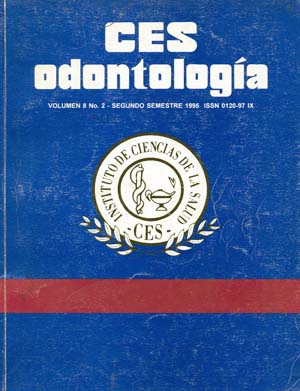COMPARACION DE ESFUERZOS TENSILES Y COMPRESIVOS ENTRE UN MODELO CANTILEVER CON IMPLANTES Y OTRO CON DIENTES NATURALES COMO PILARES, MEDIANTE EL METODO DE ELEMENTOS FINTTOS
Resumen
Comparación de esfuerzos tensiles y compresivos entre un modelo de cantiléver con implantes y otro con dientes natura/es como pilares, mediante el método de elementos finitos. CES Odont 1995; 8:109-115.Se generó un modelo matemático tridimensional que representaba una prótesis parcial fija de tres unidades Con un póntico en cantiléver y sus estructuras mandibulares de soporte. Uno de los modelos tenía dientes naturales (primeros premolares) y el otro implantes óseointegrados como pilares, ambos con un póntico Posterior en cantiléver. Por medio del análisis de elementos finitos se realizaron cálculos de distribución de esfuerzos cuando se le aplicó a los modelos una carga de 26.7 kg de magnitud en nueve diferentes condiciones (dirección y cantidad).— Los resultados mostraron tina diferencia importante entre el comportamiento de ambos modelos, la cual se atribuyó a la elasticidad del modelo con dientes naturales debida a la presencia de Ligamento periodontal y dentina, mientras que el modelo de implantes era más rigido por la carencia de esos elementos. Por tanto, se puede afirmar que el modelo de dientes naturales es biológicamente más aceptable. Mientras que el de implantes lo es mecánicamente. ABSTRACT Comparison of tensile and compressive stresses between a model of cantilever with implants and another one with natural teeth as abutments, by means of the finite element method. CES Odont 1995; 8:109-115.A three-dimensional mathematical model was generated representing a three unit cantilever fixed partial denture and its supporting mandibular structures. Both models had a posterior cantilever pontic with one of them using natural abutment teeth (premolars) while the other one used implants. By means of a finite element analysis, calculations were made for stress distribution under fine different quqntitative and direction conditions when subjected to a 26.7 kg load magnitude.- The results showed that there was an important difference between both models which could he altributed to the elasticity of the natural tooth model, given the presence of periodontal ligament and dentin. In comparison with the rigid structure of the implant model. It was therefore concluded that the natural tooth model was more biologically acceptable while the implant model was more mechanically acceptable.Descargas
Los datos de descargas todavía no están disponibles.
Descargas
Publicado
2011-08-18
Cómo citar
1.
Castaño Ibarra MC, Pedroza Garcés A, Vásquez Gómez ML. COMPARACION DE ESFUERZOS TENSILES Y COMPRESIVOS ENTRE UN MODELO CANTILEVER CON IMPLANTES Y OTRO CON DIENTES NATURALES COMO PILARES, MEDIANTE EL METODO DE ELEMENTOS FINTTOS. CES odontol. [Internet]. 18 de agosto de 2011 [citado 22 de julio de 2024];8(2):109-15. Disponible en: https://revistas.ces.edu.co/index.php/odontologia/article/view/1408
Número
Sección
Artículo de Investigación Científica y Tecnológica
| Estadísticas de artículo | |
|---|---|
| Vistas de resúmenes | |
| Vistas de PDF | |
| Descargas de PDF | |
| Vistas de HTML | |
| Otras vistas | |



